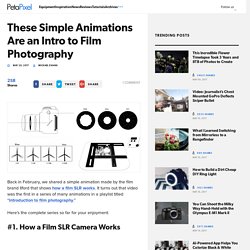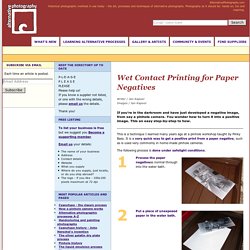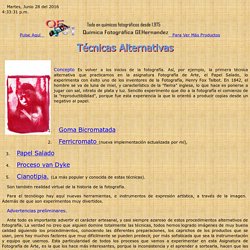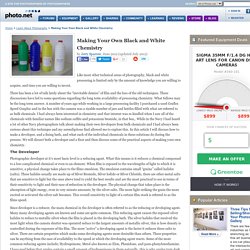

These Simple Animations Are an Intro to Film Photography. Back in February, we shared a simple animation made by the film brand Ilford that shows how a film SLR works.

It turns out that video was the first in a series of many animations in a playlist titled “Introduction to film photography.” Here’s the complete series so far for your enjoyment: #1. 20114271220441194. 2006130201152306. Wet Contact Printing for Paper Negatives « Negatives. Writer / Jan KapoorImages / Jan Kapoor If you’re in the darkroom and have just developed a negative image, from say a pinhole camera.

You wonder how to turn it into a positive image. This an easy step-by-step to how. This is a technique I learned many years ago at a pinhole workshop taught by Pinky Bass. It is a very quick way to get a positive print from a paper negative, such as is used very commonly in home-made pinhole cameras. The following process is done under safelight conditions. Process the paper negativeas normal through into the water bath. Put a piece of unexposed paper in the water bath. Make a sandwichwith the negative face down on top of the emulsion side of the unexposed paper. Squeegee all the water out to make total contact between the two papers.
Técnicas Fotográficas Alternativas. Martes, Junio 28 del 20164:33:28 p.m.

Making Your Own Black and White Chemistry. Like most other technical areas of photography, black and white processing is limited only by the amount of knowledge you are willing to acquire, and time you are willing to invest.

There has been a lot of talk lately about the “inevitable demise” of film and the loss of the old techniques. These discussions have led to some questions regarding the long term availability of processing chemistry. What follows may be the long term answer. A number of years ago while working in a large processing facility I purchased a used Graflex Speed Graphic and in the box with the camera was a sizable number of jars and bottles filled with what are referred to as bulk chemicals. I had always been interested in chemistry and that interest was re-kindled when I saw all of the chemicals with familiar names like sodium sulfite and potassium bromide, in that box,. The Developer Photographic developer at it’s most basic level is a reducing agent.
Since this activity is too slow we need to speed it up. Fórmulas y procedimientos especiales de Laboratorio. Para ir a un tema predeterminado de esta página haga Clic aquí y seleccione lo que busca Algunos aficionados que han tenido la gentileza de leer estas páginas, me consultan por otros métodos de revelado.

A ellos va dirigida esta nueva sección, en la que trataré de exponer procedimientos de laboratorio alternativos que en algunos casos facilitan la tarea del revelado y copia . Aparte de las variadas fórmulas que encontrara en esta página, puede si lo desea experimentar con otras alternativas desde el siguiente vínculo Reveladores Alternativos Recordar siempre que se debe mantener el orden de disolución que figura en las fórmulas , para evitar reacciones adversas y esperar la disolución de una droga antes de agregar otra Comenzaré por elrevelado y fijado del negativo ó las copias en un solo baño, lo que simplifica 4 de los pasos (revelado...freno...enjuague...fijado) pues del revelado se pasa directamente al lavado. El revelado del negativo. Para dominar bien el revelado conviene usar siempre el mismo revelador hasta conocer a fondo todas sus posibilidades, ya sea variando su dilución, temperatura o tiempo de acción.

Para comenzar lo mejor es utilizar un revelador de grano fino, con gran nitidez y acutancia, que consiga una amplia gradación tonal y que tenga un efecto muy compensador. Reveladores ya preparados y que cumplan estos requisitos existen varios, pero por encima de todos destacan dos, que os recomendamos especialmente para iniciarse en fotografía, el D-76 de Kodak y el Rodinal de Agfa. Ambos, a pesar de tener más de medio siglo de vida, siguen siendo los más utilizados, tanto por aficionados como por profesionales, y son relativamente baratos. Cada revelador, debido al tipo y proporción de los componentes químicos de su fórmula, proporciona unas determinadas características al material revelado como son: gradación tonal, contraste, granularidad, definición, etc.
Darkening the Darkroom. Darkroom unwrapped!

About 270 degrees of Ctein's darkroom, showing the plastic sheeting walls and about half of the overhead lights. No lack of lumens here. By Ctein As numerous recent conversations have made clear, a big darkroom concern is stray light. I concur. As I've made clear, I prefer black darkrooms, equipped with lots and lots of lights. This is not just an issue for me as a color printer, it comes up when I do black-and-white work. Be that as it may, this column's really about telling you how to find the stray light in your darkroom, not what color to paint the walls. Step one. Faro Hydro Hidroponía Grow Tent 30 Por 18 Por 36 Pulgadas - $ 2,643.97 en MercadoLibre. Tienda Hidroponica Cultivos Plantas Armario Reflector - $ 2,675.00 en MercadoLibre. Milliard 30 X18 X36 Mylar 100% Reflectante Hidropónica Cr - $ 2,447.41 en MercadoLibre. Milliard 30 X18 X36 Mylar 100% Reflectante Hidropónica Cr - $ 2,447.41 en MercadoLibre.